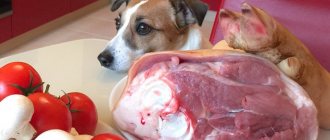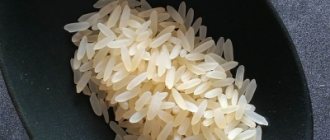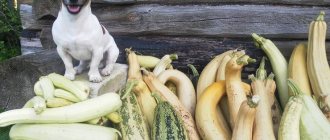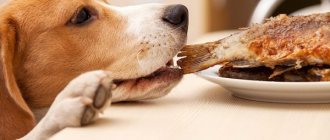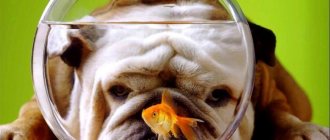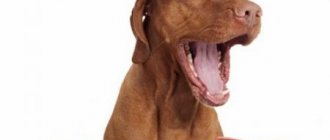Meat for dogs is the main and irreplaceable product in the four-legged diet. Meat is a source of protein, so necessary for the body of any predator. And as everyone knows, the distant ancestors of our beloved domestic animals were wolves.
Many dog owners, when switching their pet to natural feeding, including meat products in the diet, noted visible improvements in both the external and internal condition of the four-legged body: the coat became soft and shiny, allergic reactions and skin problems disappeared, the animal became energetic and active .
There are several theories about what kind of meat to feed a dog, in what form and how much of this product should be given to your pet.
The need for meat in a dog's diet
Nowadays, only a few owners of four-legged animals choose natural food. However, historically, predators, which include domestic dogs, consumed natural food obtained during hunting.
Therefore, feeding raw or cooked meat is important for dogs, and protein should form the basis of the animal's diet. From it, your four-legged friend receives the necessary substances that help:
- replenish the body with energy;
- strengthen bones and joints;
- build muscle tissue;
- normalize the functioning of the hematopoietic system;
- improve the condition of the skin and coat;
- strengthen the immune system.
The main thing is that the meat be of lean varieties, because fatty foods are poorly digested and over time provoke the development of diseases of the digestive system. The raw materials must be of good quality so that the pet does not experience poisoning or disorders in the gastrointestinal tract.
Types of meat suitable for dogs
Most owners believe that protein is a must in food. But not everyone can afford to feed their pets expensive tenderloin. In addition, not all varieties are equally useful for domestic predators.
Pork
The appropriateness of pork in a pet's diet still causes a lot of controversy. This is due to the fact that piglets eat everything, but due to physiological characteristics they do not sweat. Therefore, pork often contains toxins and helminths.
Tenderloin should not be fatty, but almost every part of the carcass contains a lot of fat. Veterinarians consider pork too heavy for the four-legged body, although they allow feeding lean parts or dietary meat of suckling pigs.
Beef
This is the most popular raw material among four-legged lovers. In addition, this is what veterinarians most often recommend, and it is best to use other parts of the carcass rather than the tenderloin.
Beef trim with film and cartilage is the healthiest food for a dog, because it contains substances that improve intestinal function and prevent constipation. Cartilage tissue contains gelatin, which strengthens bones and joints. The main requirement for raw beef for dogs is freshness and lack of fat.
Mutton
Lamb is considered a good substitute for beef for dogs. It contains many useful substances and B vitamins that help strengthen your pet’s muscles. Lamb is also rich in potassium and magnesium, which have a positive effect on the normal functioning of the cardiovascular system. Lamb fat contains half as much cholesterol as beef, but it still shouldn’t be included in your pet’s menu.
horsemeat
Horse meat is also suitable for feeding your four-legged friend. It contains a lot of protein, which is absorbed several times better than beef. Horse meat does not cause allergic reactions, and individual intolerance is extremely rare.
However, it is not recommended to frequently feed your dog horse meat. It contains very little fat, and its lack has a negative effect on the activity of animals. In addition, horse meat contains virtually no carbohydrates, which serves as an excellent environment for the development and reproduction of pathogenic bacteria - therefore, there is a risk of buying a low-quality product.
Rabbit meat
Rabbit meat is superior to other varieties in its composition. It contains many vitamins and minerals. Rabbit meat contains vitamins B and C, nicotinic acid, iron, phosphorus, cobalt, potassium, fluorine and manganese. Rabbit is a low-calorie product because it contains little fat. Including rabbit meat in the menu has a good effect on the functioning of the gastrointestinal tract.
But rabbit meat is not equally beneficial for everyone. If your pet has kidney and biliary tract diseases, then offering rabbit meat is not recommended. Its structure contains purine bases, which are converted into uric acid in the animal’s body. It is dangerous for older animals - acid crystals begin to accumulate and settle on the tendons and joints. This later leads to the development of arthritis.
Bird
Poultry is quite common on the pet menu. Usually the pet gets chicken or turkey - the most affordable and nutritionally beneficial products.
Chicken contains large amounts of phosphorus and potassium. But store-bought carcasses contain antibiotics that cause food allergies in animals, so it is better to purchase farm products.
Turkey meat is rich in vitamins A and E, potassium, calcium, iron and magnesium. It contains more sodium than beef, which is useful for normal metabolism. Turkey meat is a low-calorie variety because it contains a small amount of fat and is easily digestible, which means it can be used in dietary nutrition.
What kind of meat should you feed your dog: raw or cooked?
The debate about whether to give raw or cooked meat to a dog is still going on. Moreover, each point of view has its advantages and disadvantages.
The benefits of heat treatment
Proponents of thermally processed foods in a pet's diet primarily point out the harm of raw food. Uncooked food contains dangerous microorganisms, viruses, bacteria and parasites. And if there are fewer vitamins left in a processed dish, then they can be easily replenished with cereals, vegetables and herbs.
In addition, there are foods that need to be well boiled. For example, carcasses of wild animals and birds are given only heat-treated, since they contain many pathogens that are deadly.
Before feeding the dog, the kidneys and liver are doused with boiling water or boiled. This makes it possible to get rid of dangerous microorganisms and parasites inside the tripe.
It is also recommended to cook the bird, which will help remove long bones that are dangerous for dogs and neutralize the negative effects of hormones and antibiotics in purchased products.
What's good about raw meat?
By nature, the digestive tract of dogs is designed in such a way that it is able to extract substances beneficial to the body from unprocessed pieces of meat. In addition, supporters of feeding point out that during heat treatment, protein is destroyed and the bulk of vitamins and minerals are lost. Because of this, the cooked product contains mainly carbohydrates, so the feeling of hunger comes faster.
But is it possible to give your dog raw meat without any pre-treatment? In fact, there are certain rules and tricks:
- The piece must be doused with boiling water to kill pathogenic bacteria.
- For the same purpose, you can freeze parts of the carcass for 1-3 days.
- Bones should be removed to prevent your pet from damaging his teeth and gums.
- The food is given in large pieces: then the four-legged friend can tear and chew it, cleaning his teeth.
- Excess lard and fat are trimmed off. This will avoid problems with the liver and cardiovascular system in the future.
Whether it is possible to feed a dog raw meat or whether it is better to abstain - only the owner of the animal decides. The main thing is that the products must be fresh. If the pieces have changed color or have an unpleasant odor, then it is better to refuse feeding them.
Harm and contraindications
Despite the benefits of meat, if used incorrectly, it can cause harm to the animal.
The product can be a source of various diseases if it is not stored properly. There are varieties that should not be given to dogs:
- pork - it is fatty, which is why it is poorly digestible;
- veal - excessive consumption provokes diarrhea;
- chicken - can be infected with bacteria or filled with antibiotics;
- Duck or goose meat is fatty, so it is recommended for consumption in small quantities;
- river fish is prohibited due to the likelihood of infection with worms and injury to internal organs by bones.
Some types of meat should not be given to dogs.
Representatives of certain breeds are prone to meat allergies. This:
- Labradors;
- dachshunds;
- Dalmatians;
- Shar-Pei;
- Shepherd dogs.
Most often, allergies are caused by chicken, sometimes by rabbit, beef and veal.
It is forbidden to give dogs sharp tubular bones, which, if they enter the digestive tract, can injure the walls of internal organs.
Variety of tastes: how to complement the menu
When thinking about diet, we must remember that a pet’s body is adapted to eating protein foods. Therefore, he will not be able to be healthy and active by eating mainly plant-based foods. However, you should not neglect additives to the main diet either.
By-products
Innards are considered a good alternative to beef or lamb tenderloin. By-products are introduced into the menu of puppies from the age of 5-6 months; they are suitable for feeding animals of all breeds and ages. Thanks to the wide variety of offal, you can choose the piece that your four-legged friend will like the most.
Dogs eat almost all types of offal. So, beef tripe is very useful for puppies and adult pets. And the nutritious udder is recommended to be used for feeding disease-depleted individuals.
The main requirement when choosing is the freshness of the raw materials. You should not offer offal more than 2-3 times a week; liver and lungs should be introduced especially carefully. These parts can cause food allergies and do not have much nutritional value.
Bones
Bones are included in a dog’s menu not for satiety, but for oral hygiene. Thanks to a solid treat, the animal successfully cleanses the teeth of yellow plaque and tartar.
In addition, food debris stuck between the incisors and molars is removed. This helps prevent the development of bacteria in the mouth. While chewing, the gums are massaged, which is a good prevention of periodontal disease and gingivitis.
However, not all bones are equally useful, and some are even dangerous. You should not offer raw chicken or pork tenderloins. Tubular bones can injure the gums, and sharp fragments can harm the esophagus. Beef haunches and cartilage are suitable for feeding. Moreover, the size of the bone should be proportionate to the pet itself.
Cereals
Cereals in the diet allow you to saturate the animal’s body with essential elements and carbohydrates, which promotes proper digestion and maintenance of activity. But not every cereal is equally good. Veterinarians consider buckwheat and rice to be the best options for feeding. Less commonly used are oatmeal, barley, wheat cereals and rolled oats. Corn and pearl barley porridge is poorly digestible, so it should not be cooked.
You should not change cereals on the menu too often so as not to cause digestive upset. However, it is recommended to add another type of cereal to your usual porridge to diversify your food.
Fruits and vegetables
Fresh vegetables and fruits contain substances and vitamins that have a positive effect on the digestive system of your pet. However, not all of them are equally safe. Moreover, a dog that is not accustomed to plant foods is unlikely to eat carrots or cucumbers.
In small quantities, vegetables and fruits are introduced into the menu of puppies from six months of age. Safe types of plant-based foods include:
- carrot;
- cucumbers;
- pumpkin;
- zucchini;
- celery;
- cauliflower;
- apples;
- pear;
- bananas.
After your four-legged friend has eaten any vegetable or fruit, you need to carefully monitor his body’s reaction. If food allergies, diarrhea or diarrhea occur, this ingredient will have to be abandoned. Vegetables can be given fresh or boiled, mixing them with porridge.
Sour milk and eggs
It is recommended to add chicken or quail eggs to mixtures with other foods no more than 2 times a week. Such protein is not very well absorbed and harms the digestive system if consumed frequently. The number of eggs that are added to a pet’s dish is influenced by the size of the individual. For example, a large representative can eat many pieces without much harm, but a small individual can eat one. In addition, eggs are a strong allergen.
Milk contains protein, which is easily digestible and has a good effect on health. However, this only happens if cottage cheese, kefir or cheese have low fat content. Fatty foods lead to indigestion and diarrhea. If the owner gives his pet yogurt, it should be natural, without added sugar or canned fruit.
What to Consider When Calculating Portion Sizes
In large quantities, even healthy foods can be harmful. You should carefully calculate the portion for the animal, taking into account its needs and condition.
Breed of dog
When calculating, it is important to take into account the breed of the dog.
If she belongs to representatives prone to obesity, then meat should be given with caution, recording the pet’s weight. In case of a sharp increase in body weight, the serving size should be reduced. Representatives of large breeds that are active require more meat than small dogs.
Weight and age
You can feed your pet raw meat from an early age. The product is introduced into the diet in small daily portions - at first it is advisable to feed the puppy stroganin, and then gradually increase the size of the piece.
Meat can be given to dogs from an early age.
For energetic adults, the norm is 3-4% of body weight. For the elderly, it is reduced to 2-2.5% of the mass. Puppies need increased volume - their norm is 6%.
Lifestyle
An active animal should receive about 30 g per 1 kg. If the dog is inactive and does not like to run, then 15-20 g per 1 kg of weight is enough for such individuals. This amount should be divided into 2 feedings.
Health status
If the dog suffers from diseases of the gastrointestinal tract or other organs, then the portion size and menu are developed individually. To do this, contact a veterinarian - he will suggest the right foods, create a diet and give recommendations on feeding.
